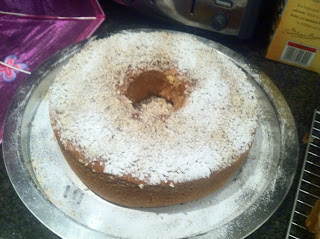Christmas Eve and I'm all prepped. Potatoes and brussel sprouts are peeled, presents are wrapped and home made mince pies are obediently waiting to be devoured. And I thought Christmas was meant to be stressful.
 |
| Presents! I'm such an only child. |
I say this with a bit of a smug grin now, but let's cut back to the other week. I admit, it was a very different story altogether...
After spending what seemed like an eternity deciding whether to cook beef or turkey, I headed to my local Waitrose (sorry, I can't help it - I'm a supermarket snob) and put in my order. A la James Martin, I decided to sack off the turkey and ordered a wing rib of beef. Heaven, in my opinion.
My mission that day was twofold. With the first task conquered, it was on to the second - however, after reading an article on the
MailOnline earlier that week, I had a hunch it was going to be somewhat of a challenge.
On the verge of selling out for it's second year running (have you guessed what it is yet?) I was intent on getting my hands on the ultimate in Christmas puddings - Heston Blumenthal's Hidden Orange Christmas Pudding to be precise.
After ordering the main, I practically legged it to the back of the store, already knowing full well where dessert would be stacked.
Alas, what was I greeted by? Empty shelves. All of them. My heart sank - what was I meant to do now?
I looked over at the Christmas puddings sitting on the adjacent shelf. It was like they were pleading with me, "Please take one of us home, we promise we taste just as good.". As much as I pitied the sorry-looking things, I just couldn't bring myself to put one in my shopping basket.
I was about to head home, feeling deflated, when a shop assistant came scurrying round the corner. What was she carrying? A hidden orange pudding! My luck was in.
I tried to act casual. Pretending to read the packaging on one of the reject puddings (which I felt were judging me by this point), she placed Heston's creation back on the shelf with indifference.
"It's the last one in store you know...", she smiled knowingly. Clearly my "play it cool" act wasn't working. "We won't get any more before Christmas. They're all out of stock".
 |
You know you're turning into your mum
when you get excited by this sort of thing. |
I practically leapt at the thing. The last hidden orange Christmas pudding in the borough. Mission accomplished!
As I headed to the till, middle-aged women were giving me what can only be described as "the death stare". One even whispered to her husband as I walked past, "How did she get one? The lady told me there were none left!". Sorry love, that's because this Christmas pud is the very last one in stock. Ha!
Now that Christmas is finally here though, it does make you think - all of that worrying for a plate of food when, in fact, life's too short to panic over these things.
So, if you're still running round like a blue arsed fly, please stop. Surround yourself with loved ones, pour yourself a festive glass of sherry and put your feet up. The mince pies are on me (recipe below if you fancy having a last-minute go).
Merry Christmas all - eat, drink (eat some more!) and be merry!
TLC x
Ingredients (makes approx. 12 mince pies)
5oz cold diced butter
8oz plain flour
2oz ground almonds
2oz golden caster sugar
1 orange (zest only)
Pinch of salt
1 egg yolk (use medium sized eggs!)
1-2 tbsp cold water
10oz mincemeat
1 beaten egg (for glazing)
Icing sugar (for dusting)
Butter (to grease)
Method
1. Preheat oven to 200c/400f/gas mark 6
2. Rub the butter into the flour, then add the almonds, caster sugar, orange zest and salt until the mixture is crumbly
3. Combine the mixture with the egg yolk and add 1-2 tbsp water until it forms a soft dough. Wrap it in cling film and chill in the fridge for 30mins
4. Roll out the pastry (not too thin or too thick!) and cut circles of around 7cm wide (use a pastry cutter or a plate)
5. Place the circles in lightly greased tart tins and spoon the mincemeat evenly into the pies
6. Roll the leftover pastry out and cut shapes for the top of your mince pies (get creative - add stars, Christmas trees, lattice effect etc etc)
7. Lightly brush the pastry tops with the beaten egg and bake in the oven for 12-15 mins until golden
8. Remove from the oven and leave to rest in the tart tin for a few minutes before placing them on a cooling rack
9. Dust with icing sugar
10. Scoff the lot! Alternatively, keep them in an air-tight tin where they will last for up to 7 days







